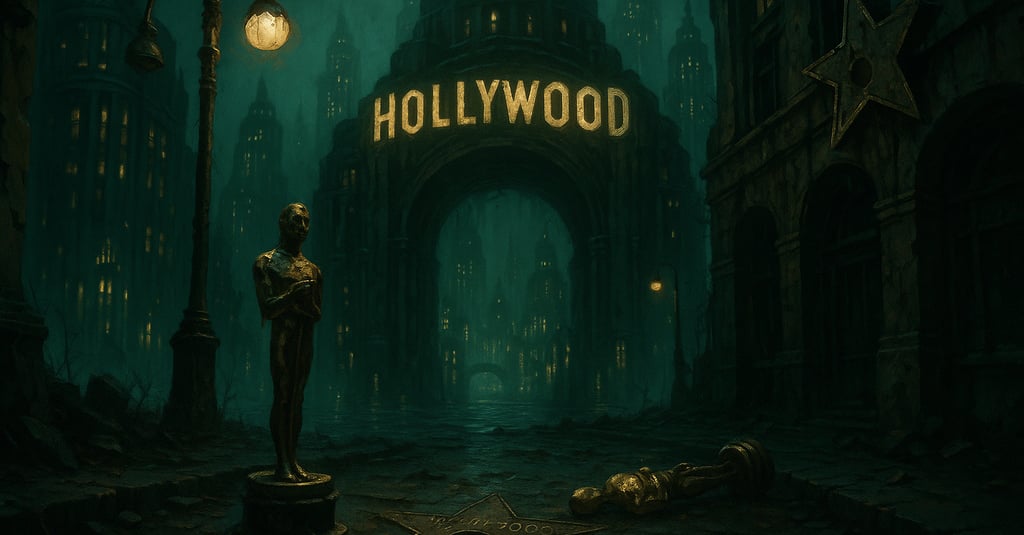The Dystopian Echo: How Hollywood's Trajectory Mirrors Rapture's Descent
Hollywood promised art and meaning. We got sequels, surgery, and self-importance.
SOCIETYMEDIA
L Hague
8/6/20253 min read


Once upon a time, Hollywood wanted to change the world. Now it mostly changes faces, and not with makeup.
In a narrative twist that BioShock players will find disturbingly familiar, the glitzy dream factory and the underwater libertarian dystopia of Rapture seem to share more than just artistic ambition: namely, an uncanny knack for destroying themselves from the inside out. Both began as utopias, one cinematic, the other subaquatic, and both now seem trapped in a high-budget death spiral of narcissism, decay, and sequels.
Rapture: Where Libertarians Go to Die Stylishly
Rapture was Andrew Ryan’s wet dream, an underwater city where artists, scientists, and businessmen could thrive without being bothered by little things like taxes or ethics. Inspired by Ayn Rand’s philosophy of Objectivism, it was a society meant to unleash human potential. Spoiler: it did. And it looked like a twisted Picasso by the end.
Despite promising freedom, Ryan banned religion, burned Bibles, and ruled with the same iron fist he claimed to detest. Turns out, utopias are delicate creatures, especially when built on ego and amphetamines.
The arrival of ADAM, a DNA-altering substance that granted powers like telekinesis and immortality (because of course it did), was the beginning of the end. Initially marketed as “just a little enhancement,” ADAM quickly became Rapture’s equivalent of TikTok filters on steroids: highly addictive, ethically murky, and increasingly grotesque. Enter the Splicers, once-normal people who now look like what happens when a Botox Groupon goes unchecked.
Unsurprisingly, the lack of government oversight also led to a fun little civil war between Ryan and a mobster named Frank Fontaine. Add mass inequality, genetic free-for-alls, and power struggles, and you’ve got yourself a society rotting in real-time.
What began as brilliance turned into decay, a self-reinforcing loop of dysfunction. Rapture wasn’t destroyed in one fell swoop. It slow-dripped into madness, like a Netflix series stretched four seasons too long.
Hollywood: The Utopia Where Everyone Has a Publicist
Meanwhile, on dry land, Hollywood followed a similar arc. It once held a mirror to society. Now it mostly holds up a ring light.
For decades, Hollywood championed social justice, from challenging racial stereotypes to confronting poverty and inequality. But that same machine also churned out its fair share of clichés and exploitation.
The industry also perfected the "cult of youth", which began in the early 20th century and never left. Today, celebrities are encouraged to age like vampires and pretend it's just good skincare. Subtle plastic surgery is now so common it’s called “preventative maintenance,” and the pressure for perfection, amplified by social media, has become so intense it could qualify as a public health crisis.
Hollywood doesn't just sell perfection, it manufactures the anxiety that drives people to chase it. The more you suffer, the more they profit. It’s the circle of life, except everyone’s face is frozen.
The Franchise Feedback Loop
Hollywood’s creative engine, once driven by bold ideas, now mostly runs on reboots, sequels, and whatever Kevin Feige is planning next. Audiences complain about the lack of originality, but also flock to see Fast & Furious 12: Tokyo Drip. The result? A self-reinforcing cycle of safe, sanitised, soulless content.
Studios justify this with data: franchises are more "sustainable" and stars are more disposable than ever. Original screenplays? Too risky. Better to just CGI Paul Walker back into existence and hope nobody notices the uncanny valley swallowing his eyebrows.
This isn’t just a creativity problem. It’s a structural one. The modern media landscape runs on engagement metrics, outrage bait, and attention economies. Truth is optional. Clicks are mandatory.
The Doomed Locomotive: Full Speed Into the Abyss
Like Rapture, Hollywood has become a closed-loop machine that feeds on its own illusions.
The relentless pursuit of beauty in Rapture led to monsters. In Hollywood, it leads to The Kardashians: Season 34. Both systems create escalating standards that normalise absurdity, whether it’s facial reconstruction or narrative bankruptcy.
Rapture collapsed under the weight of its self-obsession. Hollywood may not be far behind. Film production in Los Angeles has dropped, and the global market share of American films has slid from 85% to 69% in a decade.
Yet instead of course-correcting, the industry’s answer is to spend more, change less, and CGI another Harrison Ford back to life.
And here's the kicker: we're complicit. Rapture didn't implode because of Ryan alone, it fell because people kept demanding “just one more hit” of ADAM. Hollywood’s audience does the same. Sequels sell because we buy. Shallow news spreads because we click. The doomed locomotive keeps moving because we keep laying track.
Conclusion: Maybe Stop Taking Life Advice From Celebrities?
If Rapture teaches us anything, it’s that unchecked ambition without restraint eventually eats itself. Hollywood, with its performative virtue, obsession with youth, and inability to say “no” to the next Spider-Verse spin-off, appears to be riding the same wave, just with better lighting.
There’s still time to course-correct. But it won’t come from more filters, more franchises, or more TED Talks from actors who took private jets to climate panels.
It’ll come from demanding better from creators, from studios, and yes, from ourselves.
Because as BioShock taught us: “A man chooses. A slave obeys.”
BurstComms.com
Exploring trends that shape our global future.
Sign up for the regular news burst
info@burstcomms.com
Email me at:
© 2025. All rights reserved.
